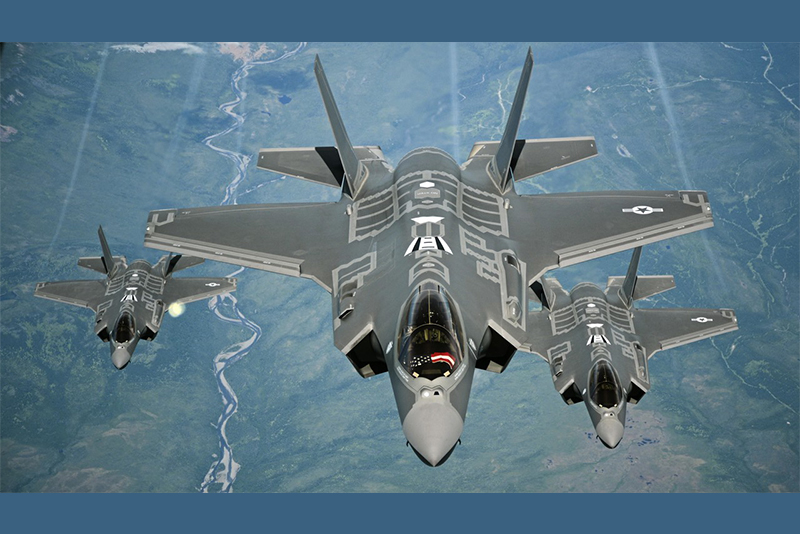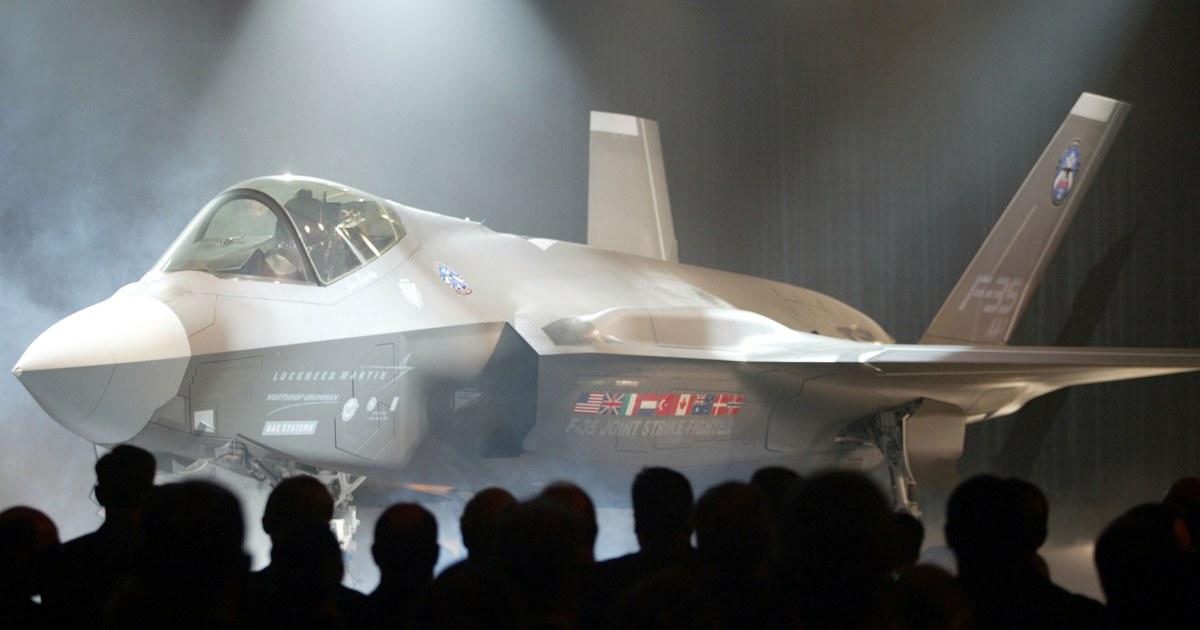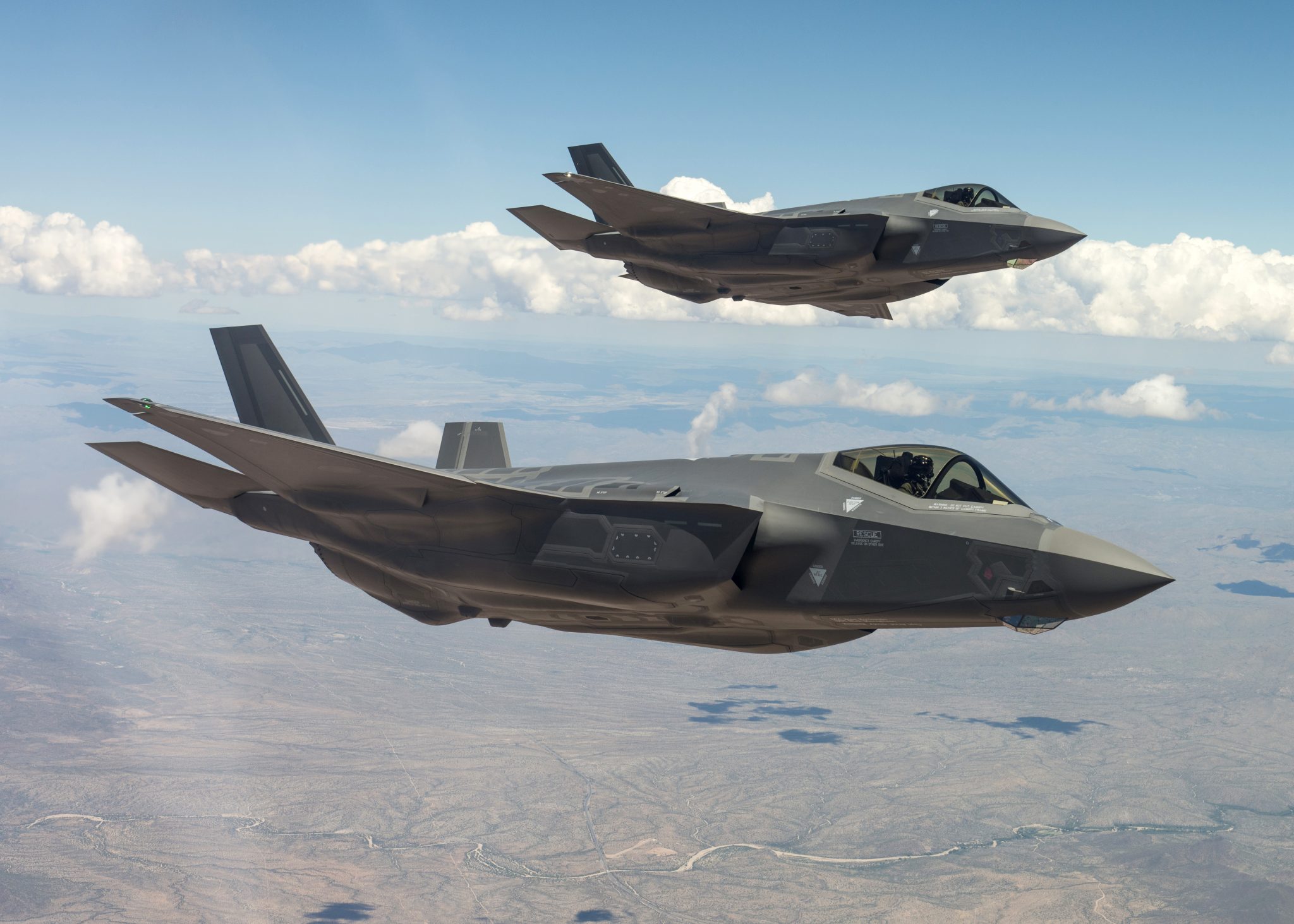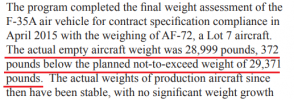Tai sitten Emiraateilla ei ole vahvuudesta 60% etätyösketelijöitä.Voi myös olla, että niitä lentävät contractorit ostettuna palveluna, jolloin tämä henkilöstö ei näy ilmavoimien vahvuudessa.
Install the app
How to install the app on iOS
Follow along with the video below to see how to install our site as a web app on your home screen.
Note: This feature may not be available in some browsers.
You are using an out of date browser. It may not display this or other websites correctly.
You should upgrade or use an alternative browser.
You should upgrade or use an alternative browser.
F-35 Lightning II
- Viestiketjun aloittaja Hejsan
- Aloitus PVM
fulcrum
Greatest Leader
Voihan niinkin olla...esimerkinomaisesti kerrotakoon kuitenkin Kuwaitin Skyhawkit (jotka oli käyneet läpi mm. Desert Stormin), brassit ostivat ne 1997 ja ilahtuivat kun näissä 20 vuotta vanhoissa koneissa oli tiimaa jäljellä vaikka kuinka. Ei niillä oltu tyhjää lennelty ympäriinsä...
Pahasti näyttää olevan keskeneräinen. Instrumentaatio näkyy puuttuvan kokonaan - näyttö näyttää olevan pelkkä tekstuurikuva
Armchair pilot
Kapteeni
Raakaa offtopikkia nää pelihommat, mutta... En pidättelis hengistystäni tuon kanssa kyllä. Instrumentaatio tuntuu olevan yksi vaikeimmista toteutettavista osista DCS:ssä. Tuossa oli muistaakseni pohjalla vanhan flaming cliffs moduulin su-27 (jep) jonka myötä alkupään modia lennettäessä kone näytti ulkoisesti F-35:ltä mutta su-27:n hytällä. melkeen mikä tahansa staattinen paneeli sen tilalla on omasta mielestäni edistystä.Pahasti näyttää olevan keskeneräinen. Instrumentaatio näkyy puuttuvan kokonaan - näyttö näyttää olevan pelkkä tekstuurikuva
Tämä on sitten outo. Eikö olisi helpompi odottaa AARGM-ER:n integrointia kun se menee sisäiseen ja sille on jo USAlainen maksaja?
Tässä aiemmasta jutusta kiinnostavaa:

Suppression Aggression - Armada International
The US Air Force is on course to receive a new Suppression of Enemy Air Defence (SEAD) in the form of upgraded Lockheed Martin F-35A combat aircraft.
F-16CJ:ssa on tälläinen värkki HARMeja varten.The USAF has not revealed how the F-35A will detect and locate hostile radars. One possibility is that the necessary algorithms to detect, locate and extract the parameters of potentially hostile radars could be added to the F-35’s BAE Systems’ AN/ASQ-239 electronic warfare system. More details on the latter can be found here. The AN/ASQ-239 is believed to cover a waveband of 500MHz to 40GHz. In theory, this allows the system to detect and analyse emissions from hostile radars. Whether extra hardware in the form of additional antennas to aid the aircraft’s precise location of hostile radars will be needed has not been revealed.
The AN/ASQ-213(V) is thought to cover a waveband of 500MHz to 20GHz. While aircraft can still deploy AGM-88 missiles without the HTS, the AN/ASQ-213(V) gives highly precise target coordinates derived from the radar’s transmissions. Adapting the F-35A for SEAD will place a premium on ensuring that at least an equivalent, if not better, level of precision vis-à-vis the AN/ASQ-213(V) can be conferred on the aircraft.
Missiles
As integral to the jet’s sensors will be the missiles it employs to engage hostile radars. The US Air Force is having an unspecified number of its AGM-88C missiles converted by Raytheon to the AGM-88F status. This adds a global positioning system and inertial navigation system to allow the missile to still target a radar based on its coordinates even if that radar’s transmissions are switched off in a bid to break the missile’s lock. The AGM-88F also includes a millimetric wave radar transmitting at frequencies above 30GHz. This aids battle damage assessment by gathering detailed imagery of the missile’s end game helping to ascertain the accuracy of the engagement.
High-speed Anti-Radiation Missile Targeting System
The High-speed Anti-Radiation Missile Targeting System, or HTS, is a system for use on the Air Force's F-16CJ Block 50/52 Fighting Falcon. This targeting system is the cornerstone of the suppression
www.af.mil
Viimeksi muokattu:
atanos
Kersantti
Jatketaan vielä offtopikkia... Taisivat jossakin mainita että tulisi olemaan A4:n tapaan stand alone-moduuli joka ei tarvitse FC3:a. Tähtäävät ensijulkaisuksi 2021 alkupuoliskoa, tosin on kyllä tuolloin varmaan todella raakile. Ihmeitä ei kannata odottaa, ei pääsyä mihinkään viralliseen dataan ja kaikki on täysin puhdasta spekulaatiota järjestelmien toiminnasta lento-ominaisuuksien mallinnukseen. Mihinkään julkiselle serverille tuolla ei pääse metsästysonnea kokeilemaan. Täysin turha DCS-kyhäelmä, mutta antaa poikien väsätä, voihan tuolla yksinään leikkiä ja tehdä tubevideoita kaverien kanssa yksityisillä suljetuilla servereillä.
Armchair pilot
Kapteeni
Jos siitä ei tarvi pistää dollareita tiskiin, niin kyllä minä käyn siitä koeajot raapasemassa. Mitä raakileisiin tulee, niin se lienee sana joka määrittää DCS:n noin niinkuin muutenkin.Jatketaan vielä offtopikkia... Taisivat jossakin mainita että tulisi olemaan A4:n tapaan stand alone-moduuli joka ei tarvitse FC3:a. Tähtäävät ensijulkaisuksi 2021 alkupuoliskoa, tosin on kyllä tuolloin varmaan todella raakile. Ihmeitä ei kannata odottaa, ei pääsyä mihinkään viralliseen dataan ja kaikki on täysin puhdasta spekulaatiota järjestelmien toiminnasta lento-ominaisuuksien mallinnukseen. Mihinkään julkiselle serverille tuolla ei pääse metsästysonnea kokeilemaan. Täysin turha DCS-kyhäelmä, mutta antaa poikien väsätä, voihan tuolla yksinään leikkiä ja tehdä tubevideoita kaverien kanssa yksityisillä suljetuilla servereillä.

F-35:n Video Data Link.
"The task is to insert relevant tactical data into the full motion video." ja sen jako sitten.
Komponentti Elbitiltä
https://www.everythingrf.com/News/detai ... I-Aircraft
https://sldinfo.com/whitepapers/cubic-a ... 35-system/
"The task is to insert relevant tactical data into the full motion video." ja sen jako sitten.
Komponentti Elbitiltä
https://www.everythingrf.com/News/detai ... I-Aircraft
Tarkempaa kuvaustaElbit Systems to Supply Power Amplifiers for the F-35 Lightning II Aircraft
March 11, 2020
Elbit Systems of America has been selected by Cubic Mission Solutions to design and develop the Full Motion Video Data Link (FMVDL) amplifier module for the communications suite of the F-35 Lightning II aircraft. The amplifier module is a critical component of increasing the aircraft's advanced sensor suite by providing enhanced situational awareness to both airborne and ground forces. The F-35 FMVDL modules will be designed and manufactured at Elbit Systems of America in Fort Worth, Texas.
Joel Friederich, Vice President of C4I & Homeland Security Solutions at Elbit Systems of America commented that this selection demonstrates Elbit America's reputation as a leader in providing innovative airborne amplifiers for military tactical communications. The F-35 full-motion video amplifier modules provide the power behind the F-35's integrated communication/data link system and enable warfighters to have full situational awareness while boosting the 5th generation combat capability of the aircraft.
Building off its legacy of airborne amplifiers, Elbit Systems of America's solutions significantly boosts power for the F-35 communication suite, while reducing the unit's size. These aspects enhance the ability of the aircraft to send and receive critical information, thereby extending situational awareness from one aircraft to an entire network of warfighters, whether they're airborne or providing ground operations.
To date, Elbit Systems of America has supplied a variety of components for the F-35, from the UHF/VHF power amplifier, to the panoramic cockpit displays, to the unprecedented F-35 Helmet Mounted Display System.
https://sldinfo.com/whitepapers/cubic-a ... 35-system/
Cubic and Full Motion Video Link Within the CNI F-35 System
SAN DIEGO – June 11, 2019
Cubic Corporation today announced that its Cubic Mission Solutions business division was selected by Lockheed Martin as the Video Data Link (VDL) provider for the F-35 Lightning II Program. Cubic’s VDL capability for the F-35 will significantly increase the aircraft’s combat capability and is an essential capability to the overall F-35 follow-on modernization program.
“We are very pleased to partner with Lockheed Martin to provide a secure video data link capability for the F-35,” Mike Twyman, president, Cubic Mission Solutions. “Our team of protected communications experts have decades of experience supplying common data link systems and we look forward to partnering on this critical program.”
“With our proven track record of managing a program from development through fielding, along with the proven performance of our software-defined radio products including the Nano Multi-band Miniature Transceiver, we are confident in our ability to deliver a low-risk, cost-effective Video Data Link solution with built-in life cycle enhancements,” said James Parys, program director, Cubic Mission Solutions.
Cubic’s offering is a secure and mission-enhancing system that easily fits within the allocated Communications, Navigation and Identification (CNI) subsystem volume. The software-defined, radio-based VDL solution features high-performance processing that can support future live video enhancements, while minimizing size, weight, power and cooling (SWAP-C). Cubic’s solution enables the F-35 to transmit and receive sensor and metadata to and from multiple ground or airborne units.
And on March 1, 2020, it was announced that Elbit has been chosen to design, develop and manufacture the Full Motion Video Data Link (FMVDL) amplifier module for the communications suite of the F-35 Lightning II aircraft.
We can add the following to this Cubic White Paper based on interviews we have conducted with two members of the Cubic Mission systems team.
In an interview with Vice President and General Manager Bradford Powell, Cubic Corporation’s C2ISR Solutions business, he discussed FMV’s enhanced role within the evolving C2 and ISR infrastructure for the integrated distributed force.
According to Powell, the clear trend line is toward significantly expanding access to imagery and FMV while improving integration between the two:
“We are working to provide context within the full motion video feeds, which will enable the operational user to make tactical decisions more effectively.”
Powell described C2 as moving from a focus on maps to command and control operating from within full motion video. Such focus will require tools that provide context easily used by the tactical decision maker.
As a relatively simple example, Powell referred to how television networks superimpose yellow first-down markers over the video of a football game. Imagine, then, the various data clusters which could be laid down over the full motion video available to the tactical decision maker in his area of interest or the area where he is operating, and one can envision the coming future of video-driven context for C2 at the tactical edge.
The task is to insert relevant tactical data into the full motion video.
“The full motion video–focused C2 environment would thereby evolve to make a broader set of intelligence products discoverable in the video.”
The overall focus is to give the local decision maker much greater context for what he is looking at in the full motion video.
Cubic’s input into the CNI system will allow the F-35 to evolve along the lines suggested by Powell.
James Parys at CMS, the man responsible for the teams working the new CNI capability into the F-35, who is the Director of Platform Communications Programs for Cubic Mission Solutions, a business division of Cubic Corporation provided further details on the Cubic engagement in CNI. Mr. Parys has more than 25 years of experience in program management and business development in the defense, information technology, and computer science industries.
Parys began his career in the U.S. Navy and, after leaving the service, has worked in industry on a variety of C2 and ISR programs.
In his current role, he manages Cubic’s platform-focused communication system program organization, which includes the F-35 Joint Strike Fighter and MQ-25 Unmanned Carrier-Launched UAS Video Data Link (VDL) programs for CMS.
As a combat system, the F-35 allows for significant upgrades over time, which is why some commentators’ notion about the F-35’s obsolescence makes little sense when one considers the aircraft’s built-in software and related hardware upgradability.
According to Parys, “We’re providing a set of cards that will integrate into our own segregated element of the CNI rack. It’s basically going to be, for lack of a better term, a rack inside a rack.
“We will take video feeds from other very complex sophisticated sensors onboard the aircraft and communicate informationto other users, whether they’re on other aircraft or on the ground, which they can leverage. Our data link’s primary CONOPSis to support close air support.”
Cubic has developed the ability to put into cards what once took up a lot of real estate and power generation to process the data and then communicate. Cubic is putting technology inside the F‑35 that is battle-tested and matured within other systems operating in the battlespace.
The data fusion on the aircraft is unique and also leverages proven technologies in step with modernization of the CNI function on the aircraft.
In other words, Cubic is harvesting their experience elsewhere and putting it on the F-35 as the aircraft matures and evolves.
They will be able to harvest some of those solutions to benefit universal enhanced capability for an ISR C2 integrated infrastructure, which is evolving for the overall force development of the integrated distributed force.
A key element of the new capabilities Cubic is providing for the F-35 is an ability to pass over the middleman, or to reduce the need to send the data to a processing center which, in turn, sorts through the data and then sends it out to the user.
Cubic is significantly reducing what one might call the tooth-to-tail relationship in the C2 and ISR infrastructure.
Parys said, “We are supplying data directly from the F-35 to the ground combat elements that have not had access to before.
“We will provide very-high-resolution information coming off the F-35sensors directlyto the ground forces.
“With our solution, we’re leveraging other capabilities, such as ISR Processing, Exploitation, and Dissemination (PED)–type capabilities to be able to clean up the video, and enable higher levels of resolution and higher contrast.
“By that I mean, being able to clear fog or see through smoke and share that view to the troops down on the ground, rather than the data having to be back-hauled to a PED station somewhere.
“The troops on the ground receive that data directly, which helps them make better, time-urgentdecisions.”
Effectively, this capability contributes to building an infrastructure that connects the ground combat element to the aircraft’s systems.
The modernized CNI takes abundant visual data and transforms it to shape a more usable data stream that supports combat operations.
Parys added, “We aregoing to reduce the whole timeline of the mission and what they need to do.
“This information can be sent to other aircraft; it can also be sent to other ground units.
“It means taking this advanced sensor in the sky and making its information available for whoever needs to leverage it and use it, whatever their mission is.
“The information will be available at an enterprise level rather than be limited to the traditional single stakeholder to single stakeholder process.”
I have argued elsewhere that one advantage of the F-35 global enterprise for defense companies, and not just the prime contractor, is to provide global users with the experience of working with a variety of companies they might not have experienced before.
This certainly is the case with Kongsberg and its F-35 Joint Strike Missile (JSM), which additionally has led to broader understanding of what their technology can provide to other combat elements.
This was demonstrated when the U.S. Navy adopted a Kongsberg strike missile being coproduced with Raytheon.
A similar positive outcome is predictable for Cubic and its engagement on the F-35.
As users become familiar with innovative processes of incorporating full motion video into a decision-making flow, we will see a demand to replicate such experiences elsewhere for other combat forces.
Parys highlighted: “We’re taking what we’re putting on the F-35 and we’re making it even smaller; fully packaged, but even smaller, and we’re putting it in the hands of users on the ground as well.”
wargame
Kapteeni
Bilge Pumps Episode 26: An F-35 Deep Dive with Special Guest Steve George | Center for International Maritime Security
By Alex Clarke Bilge Pumps, Episode 26. This is special, this is one of those times the Bilge Pumps team just gets amazed! We cannot believe how lucky we are to have this person come on our podcast yet again! This is Stephen George, Commander, Royal Navy (ret.), an aero engineer the likes of which…
 cimsec.org
cimsec.org
Jumalaati, varmaan paras F-35 sisältö mitä olen kuullut vuosikausiin.Bilge Pumps Episode 26: An F-35 Deep Dive with Special Guest Steve George | Center for International Maritime Security
By Alex Clarke Bilge Pumps, Episode 26. This is special, this is one of those times the Bilge Pumps team just gets amazed! We cannot believe how lucky we are to have this person come on our podcast yet again! This is Stephen George, Commander, Royal Navy (ret.), an aero engineer the likes of which…cimsec.org
Käydään läpi esim. mitä olisi tarkoittanut eri variantti lähtökohtana muiden kehitykseen. Sitten se kuinka Lämärin paino-ongelmaa lähdettiin ratkaisemaan erilaisilla pulteilla yms. ja miten siinä voisi käydä jos tekisi huolimatonta työtä. Siviililentokapteenin kauhistuttava esimerkki.
F-35:lla oli tosi vähän tavoiteindikaattoreita. Bertalla oli melkein vain tietyn kuorman takaisintuontikyky. Kuulemma Montrealin sopimuskin rajoittaa, ettei voi tiputella matkalle. Ceellä kuulamma laskeutumisnopeus. Toki kertoo ettei tiedä mitään joistain softapuolen salaisista indikaattoreista, joita toki USAlla on ollut. Varmaan koskee noita ABM/EW yms. juttuja.
Enkä ole vielä edes kuunnellut osaa 2. (edit: siinä taitaa olla joku 10 min toistoa alkuun edellisestä?)
F-22:lla, Typhoonilla ja F-35:lla on kaikilla ollut kuulemma painopaniikki.
Osassa 2 kohdassa 13 min vastaa kysymykseen miksi F-35 ei ole kuin F-16. Saattaa kiinnostaa kuunnella siitä kohdasta.
Kertoo, että kuulemma Sea Harrier FA2 Blue Vixen -tutkalla oli huikea (kuulemma hänen mukaan lännen paras jopa 10 vuotta - lähimmäksi tuli hänestä F-16 bl 60). Erinomainen integraatio Amraamin kanssa. Kykeni vaihtelemaan semiaktiivisen, home on jamin yms. välillä ja jopa neljälle amraamille kerrallaan.
BAE keräsi siitä kokemuksen F-35:a varten.
Hänelle itselleen FA2 osoitti mitä voisi tarkoittaa BVR kyky yhdistettynä verkottumiseen. Dominoiva suorituskyky. Hirmuiset kill ratiot. (16 min kohdalla)
FA2:n kyky vaikka se oli 3G kone osoitti sitten, että F-35:lta ei tarvinnut vaatia yksisilmäisesti tiettyä G-lukua. Joten JPO/JORD antoivat siinä löysää haluttaessa.
22 min kohdalla MADL:sta.
26.45 kertoi kuinka leading edgessä on tosi pitkälti high-gain antennia ja kun laittaa parven neljä konetta tietyllä etäisyydellä toisistaan niin onkin aika mehevä maalitusvärkki koossa.
31 min kohdalla väittää kuulleensa, että F-22:ssa oli niin paha paino-ongelma että kaikki A2G-tavara otettiin pois.
37 min kohdalla kerrotaan, että ulkoiset kantopisteet oli todellakin tarkoitus olla ja myös lisätankkien mahdollisuus suunniteltiin, muttei ole vielä ollut ajankohtaista.
43 min kohdalla kertoo kuinka vaarallista on Harrierilla tulla takaisin, vain yksi yritys kun on 800 paunaa löpöä jäljellä ja visuaalinen referenssi katsomalla ulos ja liukuminen sivuttain. F-35 pystyy taas laskeutumaan suoraan alas
47 min kohdalla kertoo ettei B kyennyt painon takia tulemaan takaisin oikein kuumana päivänä. Joten tästä jampasta tuli ilmeisesti jonkinlainen projektipäällikkö ko. keventämishankkeeseen.
1h 16 min kohdalla jostain syystä puhutaan Lahti-panssarintorjuntakivääristä

Viimeksi muokattu:
fulcrum
Greatest Leader
F-22:lla, Typhoonilla ja F-35:lla on kaikilla ollut kuulemma painopaniikki.
Typhoonilla on yli tonni ylipainoa. Alkujaan koneen piti olla samassa painoluokassa kuin Rafale. Tosin se alkuperäinen painotavoite saattoi olla lähinnä poliittisista syistä epärealistisesti asetettu jotta Saksa saadaan ohjelmaan mukaan.
Kertoo, että kuulemma Sea Harrier FA2 Blue Vixen -tutkalla oli huikea (kuulemma hänen mukaan lännen paras jopa 10 vuotta - lähimmäksi tuli hänestä F-16 bl 60). Erinomainen integraatio Amraamin kanssa. Kykeni vaihtelemaan semiaktiivisen, home on jamin yms. välillä ja jopa neljälle amraamille kerrallaan.
Blue Vixeniä on monelta taholta hehkutettu todella tehokkaana tutkana, kuulemma joiltain osin sitä pidettiin parempana kuin APG-65. Ei varmaan sattumaa että sekä Typhoonin että Gripenin tutkat pohjautuvat siihen.
Väite että se olisi Block 60:ttä parempi kannattaa kuitenkin nauttia suolaveden kera.
Tokihan se oli brittinäkökulma, jossa vedettiin hieman RAF:n/BAEn pussiin. Kertoi, ettei ole ollut ohjelmassa enää vuosikausiin joten tämä on sitä varhaisemman vaiheen kokemusta. Kehui se jotain tanskalaistakin kovasti, oli kuulemma hyvin arvostettu projektin piirissä.

Marine Corps F-35Cs Make First Arrested Landings At An Expeditionary Airfield
When it comes to austere operations, the F-35C shows it can do much of what the F-35B can and more as the Marines gear up for a fight in the Pacific.

Senate bid to block UAE arms sales falls short
Two votes seeking to block $23 billion in U.S. sales of stealth fighter jets and advanced drones to the United Arab Emirates fizzled in the Senate on Wednesday.
Suomifirma! Hauskasti toimii vielä kaikilla ilmavoimien päätukikohtien paikkakunnilla pl. Rovaniemi.
Jo vuodesta 2012 ovat olleet tekemisissä F-35:n eturungon valmistuksen kanssa.
Nyt siis myös siipien valmistukseen.
tl:dr Perkele suomipojat on rakentanut jo tuotantolinjan - Fort Worthiin.

 www.fastems.com
www.fastems.com
Toisaalta BAE:lle ovat myös ujuttaneet lonkeronsa jo 2007. F-35:n nahka ja pyrstö silloin. Näillähän on holderissa näemmä kokonaisvaltaisesti F-35:n valmistuksen ohjausta.

 www.fastems.com
www.fastems.com
Jo vuodesta 2012 ovat olleet tekemisissä F-35:n eturungon valmistuksen kanssa.

Nyt siis myös siipien valmistukseen.
tl:dr Perkele suomipojat on rakentanut jo tuotantolinjan - Fort Worthiin.

Fastems and Lockheed Martin have previously collaborated to integrate the F-35 Lightning II Forward Fuselage Machine Tool Transfer Line (MTTL) in 2012. The MTTL has been critical in improving safety, quality, and efficiency for the F-35 forward fuselage manufacturing process. For this project, Fastems built five Load Unload & Skin Installation (LUSI) Stations, a Wash Station, and the MTTL Stacker Crane at the Lockheed Martin Fort Worth F-35 plant. Further, the system was scalable to enable Lockheed Martin to meet increasing production rates since 2012, currently stretching the line to 130 meters long.

Fastems delivers laser cleaner robot for F-35 wing assembly line
Fastems is delivering two Automated Structure Laser Cleaner (AutoSLC) units for the F-35 Lightning II Wing Line.
Toisaalta BAE:lle ovat myös ujuttaneet lonkeronsa jo 2007. F-35:n nahka ja pyrstö silloin. Näillähän on holderissa näemmä kokonaisvaltaisesti F-35:n valmistuksen ohjausta.

Fastems and BAE Systems - FMS Breaking new Ground
Fastems FMS breaks new ground and improves productivity in an aerospace application – handling precision parts with specially developed technology.
Viimeksi muokattu:
Bern closes in on fighter selection
Jan 2021 Craig Hoyle
"Alpine nation’s search for next generation fleet is on target for conclusion by middle of 2021, after receiving final offers...
...Optional extras
Mike Kelley, Lockheed’s managing director in Switzerland, says its proposal includes 36 F-35As with associated training and sustainment services, plus “discrete pricing” for an optional four additional examples, to be built in the country. Should Switzerland select the stealthy type and take up the local assembly offer, work would be conducted at RUAG’s facilities in Emmen using Swiss personnel, and also cover test activities.
“Switzerland has some very unique requirements for autonomy and sovereignty in operations,” says Kelley. The experience gained from in-country assembly would boost its ability to perform MRO tasks over an expected 30-yearplus operational life, he adds.
Switzerland would join Lockheed’s F-35 global sustainment programme, and, at the request of Armasuisse, also supply a deployed spares package sufficient to support six months of normal operations.
Kelley says the offer contains a “limited” weapons package. “That package is a little bit smaller than many people would expect, but that’s because the existing inventory of munitions that the Swiss air force has for the Hornet fleet are by and large fully operational with the F-35,” he notes.
Lockheed has identified companies to place work with in “all three language regions” of the country, including directly on the Swiss aircraft. It is proposing to make Switzerland a “European centre” for F-35 transparencies and canopies, and to establish a national cyber centre, “with a testbed for network environments”.
“We believe that when fully evaluated by Armasuisse, it will be concluded that the entire 40-aircraft programme and all the other aspects will fit within the approved Swiss budget,” Kelley says. F-35A deliveries would run from 2027 to 2030...."
Lähde: Flight International January 2021
Eli Sveitsin katsotaan omistavan jo tarvittavia aseita. Tämä pätee melko varmuudella myös Suomeen, eli Amraamit uusitaan ehkä vasta joskus 2030.

